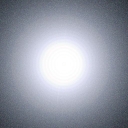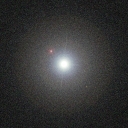Taking Pictures of Planets Around Other Stars . . .
To See What No Person Has Seen Before


What do we expect to see by using an external occulter ?
To the left and right, we see a simulation of what it
is designed to do. On the left is a representation of a bright star,
with the light from it glaring and spreading out over the field of view.
No faint objects are visible nearby because light from the central star
is so bright that it diffracts through the telescope aperture and swamps the
region near the star where planets might otherwise be visible. To the
right we see the light is reduced orders of magnitude by the occulter with faint objects
now visible nearby.
Planet Formation: Pretty pictures, like this, we won't get soon...

Prevailing theory indicates stars form in dense molecular clouds--such
as the Great Nebula in Orion--while planets form from accretion
disks about stars. These disks are the remnants of the molecular
clouds out of which the stars formed.
Planets are cold bodies that radiate most of their energy in the infrared,
while stars fuse hydrogen or other heavy elements and emit
most of their energy in the optical and ultraviolet.

Jupiter is the most massive body in our solar system, aside from the sun, and
as viewed from another star system, would be one of the
easiest planets to see...if one used large enough of a telescope and it
was not hampered by atmospheric effects. Taken in 1994, the HST/WFPC
image at right shows the aftereffects of Comet Shoemaker-Levy/9.

Saturn is less than one third of Jupiter's mass, but it is nearly as voluminous
since it has a lower average density. Because of this and its large, bright ring
system, if Saturn were at the same distance from the
sun as Jupiter, it would appear nearly as bright. Polar aurora are
visible in an HST/STIS image shown at left.

Uranus is quite small in comparison to Jupiter and Saturn, with a mass
only about 1/7th that of Saturn. It is significantly fainter given its
smaller size and greater distance from the sun.
In visible wavelengths, Uranus appears rather bland, but in the HST/NICMOS
image shown at left, many bands and
clouds are visible in addition to its own ring system and moons.
The Goal: Imaging Extrasolar Planetary Systems
The goal of is not to take such detailed pictures of planets around
other stars, which would require telescopes of far greater capability and
size than can be built with reasonable sums of money today.
Without effective apertures a thousand times greater than the
largest telescopes available today, any detail will not be achievable for
extrasolar planets.
Nevertheless external occulters will allow a search for and analyze extrasolar planets
in ways that cannot be done with current methods. External occulters could
allow already planned telescopes to see faint dots next to the very bright
stars (like in the simulation at the top of the page), tell what colors
they are, possibly take spectra of them, and measure their motions around
those stars.
 This is significantly more than what is currently achievable. The best
that can be done at present in the field of extrasolar planets is to
measure the back and forth wiggles that large planets have on their parent
stars, and measure light variations of stars as planets transit in front
of them.
At right are measures of the speed of the star 51 Pegasi along the line of
sight over a few days. The back and forth wiggles betray the presence of
a planet in close orbit around the star. Some sub-stellar objects may
already have been imaged, but these are very special in that they are
glowing in the infrared and unlike any planet in our solar system.
This is significantly more than what is currently achievable. The best
that can be done at present in the field of extrasolar planets is to
measure the back and forth wiggles that large planets have on their parent
stars, and measure light variations of stars as planets transit in front
of them.
At right are measures of the speed of the star 51 Pegasi along the line of
sight over a few days. The back and forth wiggles betray the presence of
a planet in close orbit around the star. Some sub-stellar objects may
already have been imaged, but these are very special in that they are
glowing in the infrared and unlike any planet in our solar system.
Furthermore, the imaging technique will allow determination of
whether or not planets of a certain class exist at all around those stars.
Determining what isn't there is as important for understanding how planetary
systems evolve as seeing what is there.








